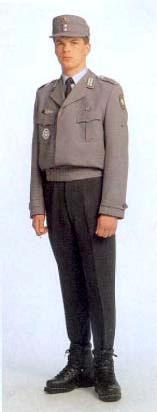Ski cap
This article includes a list of general references, but it lacks sufficient corresponding inline citations. (June 2012) |
The ski cap is a type of field cap used by several German-speaking or German-influenced armed forces since the late 19th century. The design originates from imperial
Variants
There are several variants of the ski cap, starting with the Gebirgsjäger's ski cap. This was the first in the family of caps, and was recognized by a high peak, a teardrop shaped top, a short bill, and a small skirt that folds down to protect the ears in cold. All Bergmützen had a small
Gebirgsjäger


The precursor to the German Bergmütze was a service cap first issued to Austrian
The sides of the Bergmütze stand almost straight up, due to the wide top sewn onto the cap. The skirt that surrounds the cap is made in the same wool as the cap, and is double layered in the rear three quarters of the skirt, enabling it to be folded down over the ears. The skirt has a small dip in the front quarter with a divide secured by two small buttons in order to get the skirt around the bill. The small section in the front quarter was built shorter to show the insignia, and cover the wearer's chin or mouth, without disturbing breathing by covering the nose.[2]
Use of similar headwear in Finland
The ski cap -like design was introduced in the Finnish Army and Finnish Air Force in the field uniform of model 1936, which was based on contemporary German models.
The cap was used by all ranks during the Second World War and long afterwards. As with all caps of the Finnish Defence Forces, rank-and-file and junior NCOs wore the cap with a roundel-type
Modern use


Mountain units (Gebirgsjäger) of the Bundeswehr still wear M43-style field caps, and are still referred to as Bergmütze. The caps have the fold mentioned above, and are issued in medium grey for enlisted personnel and a lighter grey with silver piping around the brim for officers. The Edelweiss is still on the left side of the cap above the ear, and the cockade and crossed-swords insignia are present on the front above the bill. Most modern M43 field caps are of a slightly different cut than the original M43, with a wider top, but still very similar to the Gebirgsjäger Bergmütze of World War II. Many modern German police units also use a variant of the M43. Additionally, all other army units wear a simplified version of the M43 cap, without the fold-down ear flaps, in standard Flecktarn camouflage with a BeVo cockade on the front. This is generally worn in the field instead of the Beret. There is also a version of lighter cloth in the desert variant of Flecktarn for use in tropical climates. The Bergmütze is also part of the formal uniform of the civil Austrian volunteer Fire Fighting services.
Gallery
-
An M43 wool field cap with SS insignia, showing folded and unfolded ear flaps.
-
3 Camouflaged M41 field caps in Heer splinter, Italian, and SS blurred edge. Note sweatband on fall side of SS field cap.
-
The original pike-grey service cap, with neck flap, issued to Austro-Hungarian troops during World War I. Unlike the German Bergmütze, this had a leather peak.
-
World War II German Gebirgsjäger in Norway. Experienced troops were allowed to wear anedelweissbadge made of metal or embroidered cloth.
-
Finnish soldiers wearing field caps based on the German pattern, 1942.
-
1980sKampfgruppen der Arbeiterklassevariant of the Bergmütze.
-
1965MHungarian armyfield cap.
See also
- Imperial Austrian Landwehr
- Nazi uniform
- Uniforms and insignia of the Luftwaffe
- Waffen SS uniform
- Kepi
References
Citations
- ^ Gebirgsjäger unter edelweiss
- ^ Gebirgsjäger in Ukraine
- ^ Talvisodan kenttälakki jää historiaan. Helsingin sanomat 2013- 04-16. Retrieved 2016-02-21. (in Finnish)
- ^ Maaluoto, M. Kaartin Jääkärirykmentti testaa kunniakomppanian uutta edustusasua. Huoltoupseeri 3/2014. Retrieved 2016-02-21. (in Finnish)







